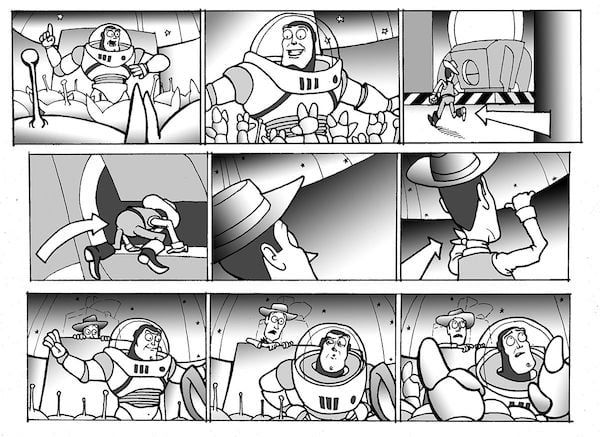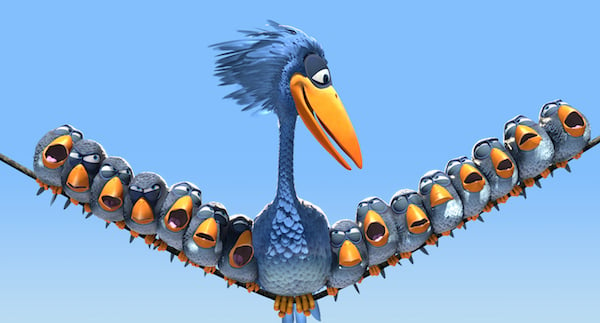How To Create 3d Animation & Visual Effects
We've all seen 3D blitheness in features, video games, advertisements and television series. Information technology is an artform that has its origins in experimentation during the 1960s but didn't become mainstream until the 1995 classic Toy Story. Now 3D blitheness is a ubiquitous and ever-expanding genre that is highly competitive to get into. If y'all desire to go far your career the first question you will ask is how exercise you make 3D blitheness and where do you start? The 3D blitheness process is circuitous and involves a number of stages that mirror filmmaking in its early and subsequently stages. Stages of 3D Animation: Let'southward take a closer look at these steps to requite an overview of what'south involved. 1. Concept The concept is the original thought or storyline of the piece. Companies such every bit Pixar will spend up to 2 years getting the script right earlier any sketches are fifty-fifty hand-drawn up. This has been the undercover to their success every bit they work to perfect the story earlier starting product. Different live-activeness filmmaking, any changes to the narrative made during the animation process would blow the budget and throw the project into chaos. 2. Storyboarding Once the script is finalized it is pre-visualized via a storyboard. Each scene is sketched out showing character activity, shot option, the sequence of action and cinematic direction. It is an of import pattern which guides the production process. Storyboard from Toy Story. (Credit: Disney/Pixar) 3. 3D Modeling Modeling is the construction of objects and characters via mathematical representation of all its elements. Rudimentary compositions of archaic shapes such every bit cubes, spheres or planes are created using vertices (points in virtual space) to form a mesh. These points are mapped onto a 3D grid and rendered into 3-dimensional objects. 4. Texturing One time the 3D object has been created information technology undergoes texturing, which is the outer layer finish of the object. This could include skin, wear or hair for a character; a metal finish for a car or machine; brickwork for a house or building; fur for an animal, etc. In a studio environment teams of texture artists focus on this stage of the process. 5. Rigging and skinning Rigging is amalgam the muscular skeletal basis of your animation. Character rigs allow the joints and moving parts of the object that will allow it to movement in a believable way. Riggers create these working skeletons on 3D animation productions. The next step is skinning which is smoothing out these joints, think of this equally providing the skin which covers the mechanics underneath the object. Maya offers tutorials on rigging & skinning 3D characters besides every bit other how-to videos on the Maya Learning Channel. half-dozen. Animation Now that you have congenital your 3d character or object from scratch you can animate them through a sequence of movements or through a scene. This is where the full storyboard is animated to realize the script. 7. Rendering Rendering, or paradigm synthesis, is the process of generating the 3D blitheness via a graphics processing unit (GPU). This is done by inputting the render equation into the software which will output a complete blithe sequence. During this process elements such as shading, texture mapping, shadows, reflection, translucency, depth of field, motion blur, etc can exist formulated into the sequence. 8. Compositing & VFX Multiple render passes volition need to be combined to produce the final animation, this is called compositing. Information technology is a process of refining elements such as lighting, shading, colors, etc which involves calculation layers to a single image or series of images. [featured] Visual effects are added in much the same mode every bit compositing. The illusions and visual tricks that enhance the scenes and characters are added as separate renders and layered onto the existing animation using a compositing plan. 9. Music & foley All the sound elements of animation are created in a sound studio. This includes the recording of the score, all the musical elements and flourishes required for the animation. The music is timed to accompany and complement the visuals. Foley is the production of all the sound effects required for the piece. Once these audio elements are finalized they undergo a sound edit and mix to sync with the activeness. 10. Editing Even though animation is strictly storyboarded it does need an edit to fourth dimension out the sequences, cut to the scenes and last audio edit. 11. Final output In one case all the elements take been animated, rendered and refined it is fourth dimension for the last render. When product is complete and the final polishes are in the can the render button is pushed and at that place is no turning back! Blitheness completed! Pixar's classic blithe curt For the Birds was a simple story told well. (Credit: Pixar) This is the process for how to make 3D animation on a large-scale production. If it sounds like something you'd love to be a part of you can start working on your own minor animations. You are in charge of a mini version of this process. Write out your script. Who are your characters? What is your storyline? It could just be a minor scene or scenario. Do storytelling through visuals, audio, character and sound. There are a range of 3D animation platforms on the market, with Maya being the industry standard. Y'all can start by cocky-learning with your own experiments in 3D animation, notwithstanding, navigating your way through the complexities of the genre can be daunting equally y'all push yourself to produce more sophisticated piece of work. To take your skills to expert levels and build a professional portfolio you lot will need formal training and guidance. That is where CG Spectrum'due south courses can help launch your career. Trace how Pixar has changed 3D technologies with each of its titles. View part 2 hither. At CG Spectrum we offer a comprehensive 3D Animation Form that will guide you through the product process and equip you with the skills to land yourself a job in the industry. Taught past professional animators who volition act equally mentors during the course, y'all volition be trained in the basics of animation, how to ready workflows, and build a professional portfolio of your own work. Anyone can acquire how to make 3D blitheness on their ain by studying the principles of animation and downloading 3D blitheness software from the net. If you lot desire to make information technology your career consider the valuable guidance that experts in the field can impart to you. Information technology is an invaluable investment in your future as a 3D animator. LEARN 3D ANIMATIONHow to make 3D animation


How to outset your career as a 3D animator
Ready to make your own 3D blitheness from scratch?
Source: https://www.cgspectrum.com/blog/how-to-make-3d-animation
Posted by: masonpate1995.blogspot.com

0 Response to "How To Create 3d Animation & Visual Effects"
Post a Comment